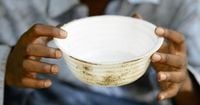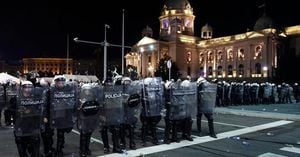In a year already marked by extraordinary hardship for refugees across the globe, a pair of major policy shifts and aid cutbacks have deepened the crisis for some of the world’s most vulnerable populations. In Kenya, queer refugees—already at risk due to violence and discrimination—are now starving as food rations at the sprawling Kakuma refugee camp have been slashed. Meanwhile, in Washington, the Trump administration has announced a dramatic reduction in the number of refugees allowed into the United States, with the vast majority of those coveted slots reserved for white South Africans, leaving countless others stranded in desperate conditions.
For many queer refugees in Kenya, the situation has gone from bad to worse. Kakuma, one of the world’s largest refugee camps, houses more than 300,000 people fleeing violence, privation, and political persecution from across East Africa. But as of November 1, 2025, severe cuts to food rations—driven by foreign aid budget reductions imposed by the Trump administration and mirrored by the United Nations and other Western donors—have left many residents facing days without food, or surviving on just one meal per day.
“Refugees are going days without food, and those who can afford to buy are forced to do with one meal per day,” said Terry Namalo, a 25-year-old Ugandan trans woman who fled Kakuma in September for a safe house in Nairobi. “The hunger became too much,” she told Context. Her story is far from unique. According to Lucretia, coordinator of the LGBTQ+ rights group Queers of Kakuma, “The food crisis in the camp has complicated the situation of already vulnerable queer refugees. They are being targeted (and) attacked, and other refugees are stealing the little food they have.”
The scale of the crisis has forced at least 200 vulnerable queer refugees to leave Kakuma and seek shelter in Nairobi between June and October 2025 alone, Lucretia said. Yet, the capital’s safe houses are now buckling under the strain. “The number of those making (their) way out of Kakuma is so huge that the available safe houses cannot handle it,” warned Craig Paris, executive director of the Refugee Coalition of East Africa (RefCEA). “We are not only worried about the shortage of food but also about overstretched water, sanitation and hygiene services,” Paris added, noting that residents are increasingly at risk for diseases like cholera.
At the Kipepeo shelter in Nairobi, the numbers are staggering. “Our safe house can only accommodate 40 persons, but now we are housing 96,” said Gregory, who oversees resource mobilization at the shelter. “We are only able to provide dinner to the refugees. We have three people sleeping on one mattress, while others sleep on bare floors.” Other shelters, such as one run by MAREPA—a refugee-led nonprofit with a presence in both the United States and Kenya—are also overwhelmed. Designed for 30 residents, the MAREPA safe house now hosts more than 100, forcing the lesbian safe house to open its doors to other queer refugees from Kakuma.
Even these overcrowded safe houses aren’t immune to violence. Some residents are so fearful of attacks that they rarely venture outside. Their fears are justified: one incident saw neighbors storm a shelter on the outskirts of Nairobi after complaints about the number of people entering and leaving the compound. “They injured three people before police intervened and saved the situation,” recounted Charity, the safe house’s administrator.
With the crisis deepening, food scarcity has followed refugees from Kakuma to the shelters. “The requests are overwhelming,” Gregory said, underscoring the desperate need for more resources. Mercy Juma, head of communications for the U.N.’s World Food Program in Kenya, was blunt in her assessment: “Without adequate funding, the situation will only get worse for refugees.”
While refugees in Kenya face starvation and violence, a new policy in the United States threatens to close off one of the last remaining lifelines for those seeking safety. On November 1, 2025, the Trump administration announced it would restrict annual refugee admissions to just 7,500 for the 2026 budget year—a historic low since the inception of the U.S. refugee program in 1980. The vast majority of those admissions will go to white South Africans, known as Afrikaners, a move that has sparked outrage among refugee advocates and human rights groups.
The new cap, published in the Federal Register, represents a steep drop from the previous ceiling of 125,000 refugees set under President Biden. The administration offered little explanation for the drastic reduction, stating only that the admission of 7,500 refugees was “justified by humanitarian concerns or is otherwise in the national interest.” No other specific groups besides white South Africans were mentioned for admission, though the notice vaguely referenced “other victims of illegal or unjust discrimination in their respective homelands.”
Refugee resettlement agencies were quick to denounce the move. “This decision doesn’t just lower the refugee admissions ceiling. It lowers our moral standing,” said Krish O’Mara Vignarajah, President and CEO of Global Refuge, as reported by the Associated Press. “To concentrate the vast majority of admissions on one group undermines the program’s purpose as well as its credibility.”
Since President Trump first suspended the refugee program on his first day in office, only a trickle of refugees—primarily white South Africans—have been admitted. Some exceptions have been made for refugees already in the pipeline as a result of ongoing court cases. But for the thousands of others who have been rigorously vetted and approved, the wait has become indefinite and dangerous. “By privileging Afrikaners while continuing to ban thousands of refugees who have already been vetted and approved, the administration is once again politicizing a humanitarian program,” said Sharif Aly, president of the International Refugee Assistance Project.
The new policy also leaves out other nationalities, including Afghans, many of whom have been desperately trying to flee the Taliban since the U.S. withdrawal in 2021. Although a separate program remains for Afghans who worked closely with the U.S. government, tens of thousands who contributed to the U.S. mission have been largely shut out from refugee resettlement. “I think we need to face facts. This means that the president and the White House ... are not going to allow Afghan refugees to come here,” said Shawn VanDiver, president of #AfghanEvac, in a video posted to Instagram. “This is a really bad day.”
Presidents have broad authority to set the refugee admissions cap, typically consulting with the State Department and resettlement agencies. Yet, the current restriction marks not just a policy change but a profound shift in the country’s approach to humanitarian crises. As the United States, once a beacon for those fleeing war and persecution, turns inward, the ripple effects are felt around the world—in overcrowded shelters in Nairobi, in the dusty lanes of Kakuma, and in the hearts of refugees left waiting, hoping, and hungrier than ever.
With aid dwindling and doors closing, the plight of refugees in Kenya and beyond stands as a stark reminder of the human cost of political decisions made half a world away.




